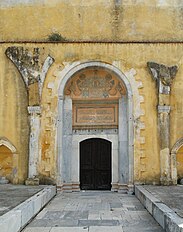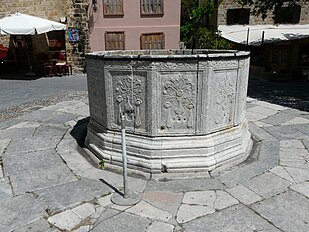| Mustafa Pasha Mosque | |
|---|---|
 Mustafa Pasha Mosque in Rhodes | |
| Religion | |
| Affiliation | Sunni Islam |
| District | Rhodes |
| Province | South Aegean |
| Ecclesiastical or organizational status | Open on occasions |
| Location | |
| Location | Rhodes, Greece |
| Geographic coordinates | 36°26′34″N 28°13′31″E / 36.44278°N 28.22528°E |
| Architecture | |
| Type | Mosque |
| Founder | Mustafa III |
| Completed | 1764–1765 |
| Specifications | |
| Dome(s) | 1 |
| Minaret(s) | 1 (destroyed) |
| Materials | Stone, brick |
The Mustafa Pasha Mosque ( Greek: Τζαμί Μουσταφά Πασά, from Turkish: Mustafa Paşa Camii) is a historical Ottoman-era mosque in the Aegean island of Rhodes, in southern Greece. It is located within the old walled town of Rhodes, and although no longer open for regular use and worship (which is the case for the vast majority of Ottoman mosques in Rhodes, with the exception of Ibrahim Pasha Mosque) it has been occasionally made available to the Muslim community, especially for weddings. It stands on a small square right next to the town's hamam. [1]
History
Located in Arionos Square, in the same area as Suleiman's bath, also known as the Yeni Hamam ("new bath"). A marble inscription on the door frame names its founder as Sultan Mustafa III, who erected the mosque around 1764 or 1765. [2] [3] [4] The bath was also built by Sultan Mustafa. [2]
The mosque and the octagonal fountain in the yard were both registered by the Greek Ministry of Culture in 1948, shortly after the Dodecanese islands joined Greece following some decades of Italian rule. [2] The mosque's minaret was taken down in 1973, and remains destroyed to this day. [1] Likewise, the large marble portico of the mosque no longer exists.
The façade, coloured bright yellow, and the roof were renovated in the mid-2010s. The mosque has been used as a wedding office by the Muslim community of the island since 1977. [2]
Architecture
The mosque has a rectangular shape, with interior dimensions of about 13.7 × 10.7 metres. [5] Its roof has one large dome in the center, surrounded by two vaults in East-West direction, and two smaller, shallow domes in the middle. [2] The central dome covers the square fronting the prayer-niche, while the rectangular vaults were chosen to accommodate the square shape of the roof. [6] The use of vaults in Ottoman mosque and in Rhodes in particular is rather rare, so the ones in the Mustafa Pasha Mosque constitute the sole example of their kind in the whole island. The vaults' roofs are covered with lead stripes. [6]
The prayer-niche has a special shape in comparison to the niches in the mosque of the rest of the island, as it is not hollowed nor very deep, less than a quarter of a circle. [7] It is crowned with an arch the shape of a crescent moon, and surrounded by two cylindrical columns with a rectangular base and Corinthian capitals on their top. [7] Nothing whatsoever survives of the portico, which was once considered to be one of the biggest in Rhodes' mosques; Its dimensions are about 17.5 × 6.5 m., consisting of two aisles, and arches that were caarried by a total of four columns made of marble. [8]
The minbar of Sultan Mustafa Pasha mosque is among the largest of the surviving marble minbars on the island, made of pieces of grey coloured marble and adorned with a top decorated with Arabic ornaments; underneath is found a writing inscription containing the Shahada, that is the Islamic declaration of faith. [9]
Gallery
- Mustafa Pasha Mosque
-
The entrance.
-
Lower view.
-
Façade.
-
Fountain.
-
Remains of the minaret.
See also
References
- ^ a b Louloudaki, Rhodoula (26 November 2018). "Τα τζαμιά της Ρόδου!" [The mosques of Rhodes!]. rodiaki.gr (in Greek). Retrieved 28 October 2023.
- ^ a b c d e Konuk 2008, pp. 66–67.
- ^ Fakiolis, Vlasis. "Θρησκευτικά μνημεία" [Religious Monuments]. rhodes.gr (in Greek). Rhodes Municipality. Retrieved 28 October 2023.
- ^ Kaurinkoski 2012, p. 51.
- ^ Panagiotidi, Kalopisi & Mamaloukos 2010, p. 69.
- ^ a b Panagiotidi, Kalopisi & Mamaloukos 2010, pp. 71–73.
- ^ a b Panagiotidi, Kalopisi & Mamaloukos 2010, p. 78.
- ^ Panagiotidi, Kalopisi & Mamaloukos 2010, p. 85.
- ^ Panagiotidi, Kalopisi & Mamaloukos 2010, p. 79.
Bibliography
- Kaurinkoski, Kira (2012). "The Muslim communities in Kos and Rhodes: Reflections on social organization and collective identities in contemporary Greece". In Jouko Lindstedt; Max Wahlström (eds.).
Slavica Helsingiensia 41 – Balkan encounters: old and new identities in South-eastern Europe (PDF).
Helsinki.
ISBN
978-952-10-8539-0.
{{ cite book}}: CS1 maint: location missing publisher ( link) - Konuk, Neval (2008). Ottoman architecture in Lesvos, Rhodes, Chios and Kos islands. Ankara: The Center for Strategic Research. ISBN 978-9757307693.
- Panagiotidi, Maria; Kalopisi, Sophia; Mamaloukos, Stavros (2010).
"Τα οθωμανικά τεμένη στην παλαιά πόλη της Ρόδου: Σουλτάν Σουλεϊμάν τζαμί, Μουράντ Ρέις τζαμί, Σουλτάν Μουσταφά τζαμί, Μεχμέτ Αγά τζαμί" [The ottoman mosques in the old town of Rhodes: Sultan Suleiman mosque, Murad Reis mosque, Sultan Mustafa mosque, Mehmet Agha mosque]: 23–25.
doi:
10.12681/eadd/25418. Retrieved 23 November 2022.
{{ cite journal}}: Cite journal requires|journal=( help)
External links
-
 Media related to
Mustafa Pasha Mosque at Wikimedia Commons
Media related to
Mustafa Pasha Mosque at Wikimedia Commons







